The Gougeon Brothers
~ Gentlemanly Indomitability
Previously published in Dinghy Cruising Association Journal, Issue No. 235
- Go to part 2 of this essay
Jan and Meade Gougeon wanted to build better boats and repair fiberglass ones. No matter the brand of epoxy you and
I have used, broad applications to boats began in Bay City, Michigan in the 1960s, as the brothers built DN ice boats,
and Meade's trimaran Adagio in 1969-70.
My first use of their glue was in 1972-3 when I bought some for my dad. Hal had decided to build a strip canoe in the dining room in Michigan, while my mother was visiting her parents in Florida. I'd talked once on the phone with Jan about the suitability of kiln-dried pattern makers' lumber, which he said was ideal. When I picked up the epoxy in the big boat shop, Jan, I think, was the fellow who handed it to me.
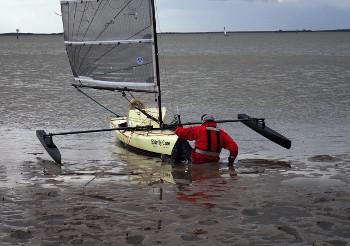 Hal did build a comely solo canoe. Once, though, after a batch had been mixed, when the AT & T princess telephone rang
he inadvertently glued the phone to its wall bracket.
Hal did build a comely solo canoe. Once, though, after a batch had been mixed, when the AT & T princess telephone rang
he inadvertently glued the phone to its wall bracket.
In 1998, Meade saw my sailing canoe Puffin slipping up a light breeze at an event the Gougeons sponsored. He sailed her and wanted to buy her, but I built him a better one, Serendipity.
Soon we realized we had many common interests beyond boats, including the Detroit tigers baseball team, and politics. In later years he would often cite us as an example of friends having respectful disagreements.
In 1999, when i delivered Serendipity, I'd 'challenged' him, he said, to develop a better rig. Within months
he'd built two, then a third, and on and on.
Part of Meade's fascination with canoes was because the church kept good family records. He knew some of his ancestors had been Voyageurs of the fur trade.
In 2000, our first fall trip to the North Channel of Lake Huron was on part of the Voyageurs' canoe route from Montreal westward, that started in the middle 1600s and lasted a couple of hundred years.
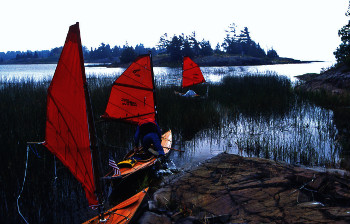 Driving the two hundred foot high bridge over the five miles wide Straits of Mackinac is always exhilarating. It's a
wild place, shaping weather and history at a crossroads of the big lakes. Windows down, we craned our necks looking east
and west, smiles bursting. Meade had been keyed up for weeks, buying charts and camping gear, paddling at least every
other day, setting his tent and lighting his backpackers' stove. Below us was the route of the Voyageurs.
Driving the two hundred foot high bridge over the five miles wide Straits of Mackinac is always exhilarating. It's a
wild place, shaping weather and history at a crossroads of the big lakes. Windows down, we craned our necks looking east
and west, smiles bursting. Meade had been keyed up for weeks, buying charts and camping gear, paddling at least every
other day, setting his tent and lighting his backpackers' stove. Below us was the route of the Voyageurs.
Had we been above the straits two hundred years before, we'd likely have seen huge canoes lugging stores and trade goods west and furs east,unless the weather forbade it.
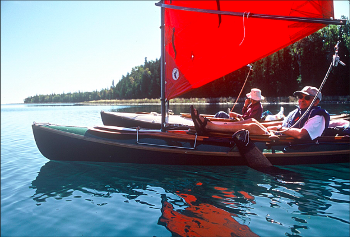 His first night in a tent since his youth, meade slept over ten hours. In the morning I was fidgeting. I'd had coffee
hours before and wanted to make his. I'd begun to be concerned,but I could hear snores. How could a fellow sleep so long
on jumbled, angular blocks of precambrian rock, even if an irregular, foot thick layer of moss was beneath his tent? He
said it was one of his best sleeps in decades.
His first night in a tent since his youth, meade slept over ten hours. In the morning I was fidgeting. I'd had coffee
hours before and wanted to make his. I'd begun to be concerned,but I could hear snores. How could a fellow sleep so long
on jumbled, angular blocks of precambrian rock, even if an irregular, foot thick layer of moss was beneath his tent? He
said it was one of his best sleeps in decades.
The next night's island had a tiny grassy-sandbar meadow. Before sunset, with a bottle of wine, we clambered a hundred yards to the island's west side.
From sunset into dusk we were enthralled by a swath of flashing thunderheads over calm Georgian Bay, too distant to
hear. Back at the tents, the moon came up as bright as a headlight. Later, something big trundled down the hill behind
us, heavily crunching brush. In the morning, moose tracks were in gravelly mud thirty yards from our tents.
The next year, September 12th, 2001, Meade and I drove our canoes again to the North Channel. We'd waited a day from our plan because of the twin towers' tragedy. Although we'd feared a long delay, only customs' officials were at the Canadian border.
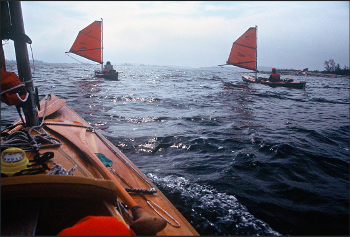 That year we came to the Whalesback Channel from the west end, overlapping the previous year's trip. Again, freight
canoes, twenty to forty feet long were in our minds' eyes. Behind every near point or far headland we could imagine one.
Meade said that often over three thousand boats had plied the North Channel, from just-melted ice in the spring to
re-frozen in the fall.
That year we came to the Whalesback Channel from the west end, overlapping the previous year's trip. Again, freight
canoes, twenty to forty feet long were in our minds' eyes. Behind every near point or far headland we could imagine one.
Meade said that often over three thousand boats had plied the North Channel, from just-melted ice in the spring to
re-frozen in the fall.
Six Serendipity sisters, including Jan Gougeon's Spirit and a second one for Meade, were built in the Gougeons' big boat shed in 2002. Jan's self-taught, prodigious engineering acumen saw the leeboard as a propeller on an axle. Now the axle is a taper in a cone-clutch for friction adjustment. it's a superb system of mounting and control, and easier to build.
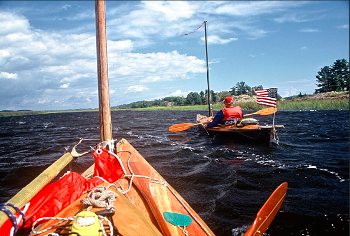 Jan, Meade and I went back three times to the northern Great Lakes on four-day fall trips, twice to the Whalesback. In
2005 we stopped eighty miles west in Michigan's Les Chenaux islands, on the Voyageurs route toward Lake Michigan and
the Mississippi rather than north to Lake Superior.
Jan, Meade and I went back three times to the northern Great Lakes on four-day fall trips, twice to the Whalesback. In
2005 we stopped eighty miles west in Michigan's Les Chenaux islands, on the Voyageurs route toward Lake Michigan and
the Mississippi rather than north to Lake Superior.
From my view, the jollity of the two of them, their staunch 'brotherliness,' and unaware lapses into comic interplay - all made delightful companionship.
In Florida in 2007, the three of us loaded our canoes on the thirty-two foot Gougmaran, Meade's efficient power catamaran. On a whim, both had bought fishing rods and reels before we left. We motored leisurely and unobtrusively over 200 miles from mid-Florida south to the everglades, but too fast for trolling for fish.
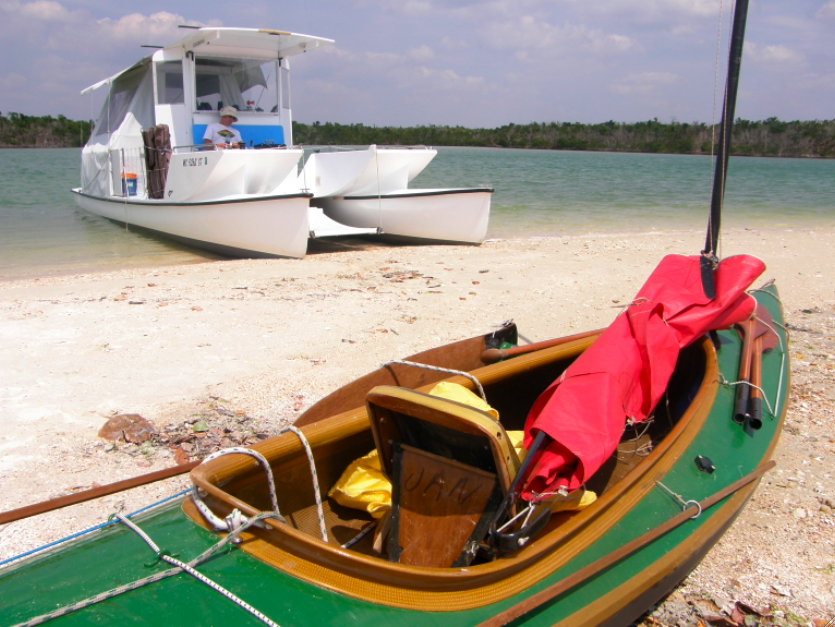 Meade enjoyed running the boat and watching a new chart plotter, so Jan and I talked, mostly about two boat categories:
cruising sailing canoes, and a three to three and a half plywood sheets long, simple version of his Gougeon 32 catamaran
from 1990 - one of which, Incognito, sailed by Russell Brown, was the first solo finisher in this year's Race to
Alaska. Jan's imagined ply cat was meant for here - the shallow, mangrove edged waterways behind the Gulf of Mexico's
barrier islands - sliding by us at ten knots.
Meade enjoyed running the boat and watching a new chart plotter, so Jan and I talked, mostly about two boat categories:
cruising sailing canoes, and a three to three and a half plywood sheets long, simple version of his Gougeon 32 catamaran
from 1990 - one of which, Incognito, sailed by Russell Brown, was the first solo finisher in this year's Race to
Alaska. Jan's imagined ply cat was meant for here - the shallow, mangrove edged waterways behind the Gulf of Mexico's
barrier islands - sliding by us at ten knots.
After three days in the 'Glades, Meade's check-in phone call brought a request to come home. We quickly loaded the boats and hurried back at over twelve knots on the Gulf, a mile or two off the long beaches, only coming in for fuel.
- Go to part 2 of this essay